Don't wanna be here? Send us removal request.
Text
The Expression of Culture and Identity Through Art
Introduction
Culture is what unites groups of people. Think back to high school, where students were separated by grade, academic level, and social status. Niche upon niche spread among an entire student body, where everyone had their place. Although some could argue that the clique-like nature of high school is a toxic social construct; I argue that those spaces that I found myself categorized into, made my high school experience feel safe.
The customs and interests I fostered among those social circles gave me room to develop a sense of identity. A sense of control. That for angsty high school me, was everything.
That is why for my final project I want to highlight the idea of cultural identity and how my chosen artists have expressed this concept through their artwork. The subject matter ahead will deal with themes such as race, sexuality, and geographical customs.
The Procuress, Dirck van Baburen, 1622, Oil on Canvas
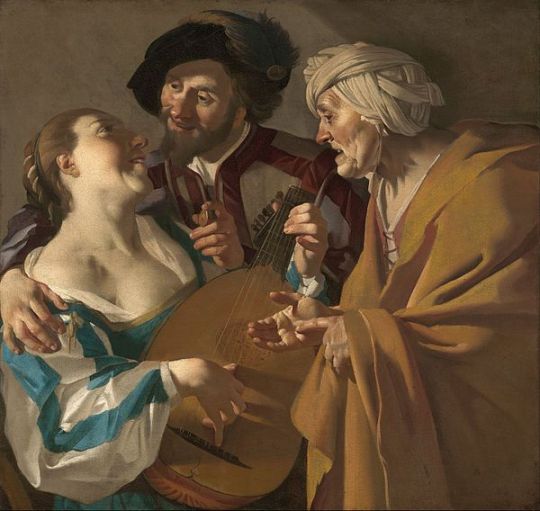
Sex work is an undeniable staple of Amsterdam. Tourists come from around the world to explore Amsterdam’s red-light district in all it’s glory. It is a location that although salacious to some, holds significant history for the people of Netherlands.
This history dates back as far as 17th century Holland which is the time and location in which our first work, The Procuress by Dirck van Baburen was created. The Procuress is a piece that highlights this cultural aspect of Dutch history by illustrating a prostitution exchange. In the painting we see the procuress, who oversees the prostitutes, soliciting her services to the male client. The male client is showing signs of interest; wrapping his arm around the prostitute, and waving his payment owed towards the procuress. An intriguing detail about the painting is the fact that Baburen displays the prostitute playing a lute identifying, the message he is intending to send regarding the subject matter of the painting. Another notable feature I noticed about the painting is the difference in appearance of the Procuress in comparison to the prostitute. The prostitute’s looks are exaggerated to create a more “desirable” female. Her chest is exposed, and she is young, while in comparison the procuress is conservative and old, almost concealing any signs of femininity.
The era in which this painting was made was known as the Dutch Golden Age, which was filled with genre paintings of brothels. In 17th century Holland there was loose laws pertaining to prostitution that did not protect sex workers, but also did not outlaw their profession. Overall, the public view of prostitution was negative; prostitutes were seen as indecent and conniving. Though, that did not stop many Dutch men from frolicking in the pleasure of sexual promiscuity. Overtime, the tides have shifted for and against sex workers in the Netherlands and it was not until 2000, that prostitution was officially legalized, hundreds of years after this painting was created. Although the tides have been inconsistent, there is no denying the impact this class of people had on developing Dutch culture.
The Emperor Napoleon in His Study at the Tuileries, Jacques-Louis David, 1812, Oil on Canvas
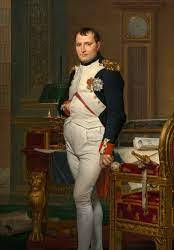
Napoleon Bonaparte, chances are that name ignites some kind of reaction in you, it sure did for those living in 19th century Europe. Napoleon Bonaparte was a French military leader who played an instrumental role in the republicans winning the French Revolution. He rose to power after the coup of 1799, where he was titled as First Consul, which established him as the new leader of France. His ruling style has been studied for years, making some view him as a dictator and some view him as a hero. He was a brilliant military leader, so once he began ruling France he started aggressively expanding into neighboring European countries. He had a “ends justify the means” approach, whether that was a good thing or not depended on if you were on Bonaparte’s good side or not. Someone who was unquestionably on Bonaparte’s good side? Jacques-Louis David.
Napoleon Bonaparte fell in love with Jacques-Louis David’s work after viewing his piece The Intervention of the Sabine Women. He wanted his grandeur to be admired on a large-scale, so he began commissioning portraits from Louis-David, one of those portraits being The Emperor Napoleon in His Study at the Tuileries by Jacques Louis-David. This piece perfectly captures the neoclassical style Jacques Louis-David was famous for. The painting emits a sophisticated level of grandeur, a grandeur that I believe is reminiscent of the French monarchy. Napoleon is posed standing among his successes. Jacques Louis-David composed the painting to allude to the idea of Napoleon staying up late in his study to finish the Napoleonic Code, which is why there is scattered pieces of paper on his desk. Near the desk, you can also see a sword hinting at Napoleon’s success as a military general. Napoleon can also be seen posing with one hand in his vest, an iconic pose commonly associated with the emperor, which stands for nobility.
The idea of the republican regime and the French Revolution was to extinguish the French monarchy, but it seems as though Bonaparte as a leader revels in it’s values. Culturally, France was supposed to move away from nobility and tighten the gap between rich and poor, but that is contrary to what we see in this painting. Napoleon relishes his riches and power and uses Jacques Louis-David’s talent to amplify that message across Europe. Although Napoleon was never crowned as a king, he breathes life into what would turn back into the monarchy later in French history.
Takiyasha the Witch and the Skeleton Specter, Utagawa Kuniyoshi, 1843 to 1847, Woodblock Print
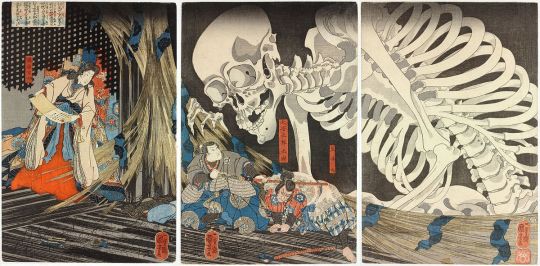
As the Greeks are famously known for their mythological gods, the Japanese have a set of their own mythological creatures and tales. One novel that makes these themes evident is from the novel Story of Utö Yasutaka written by Santö Kyöden. It is 939CE, and a Samurai by the name of Taira no Masakado is marching to Kyoto with an army to revolt against Japan’s central government. Once at Kyoto, Taira no Masakado’s army holds off against central forces for fifty-nine days before Taira no Masakado’s cousin leads an enemy battalion that demolishes his forces. Seeking revenge Masakado’s daughter, Princess Takiyasha, studies dark magic and summons a Gashadokuro, a gigantic skeleton fabricated from the bones of the fallen, to eat her uncle.
This tale is what Utagawa Kuniyoshi illustrates in his piece Takiyasha the Witch and the Skeleton Specter. Kuniyoshi’s artwork is a woodcut triptych that displays Princess Takiyasha summoning her monster by reading a spell from a scroll. Nearby, Ōya Taro Mitsukuni and a Samurai sent by the Japanese central government to arrest the princes are crouching in fear by the great giant. The most substantial accomplishment of this painting is the anatomical accuracy of the skeleton beast. In Edo Japan anatomical studies and research was far and few between in comparison to Europe at time, making this piece a spectacle.
Fables are common tradition among many cultures and have been used not only as a source of entertainment, but as a method of teaching moral lessons. This idea is no different during the time of Edo Japan, same ideas, different stories. In Ancient Greece while they were warning of Narcissus and his cursed reflection, the Edo Japanese were telling tales of Gashadokuro, beasts that bite off people’s heads.
Four-faced Hamat'sa Mask, George Walkus, 1938, wood, paint, cedar bark, and string
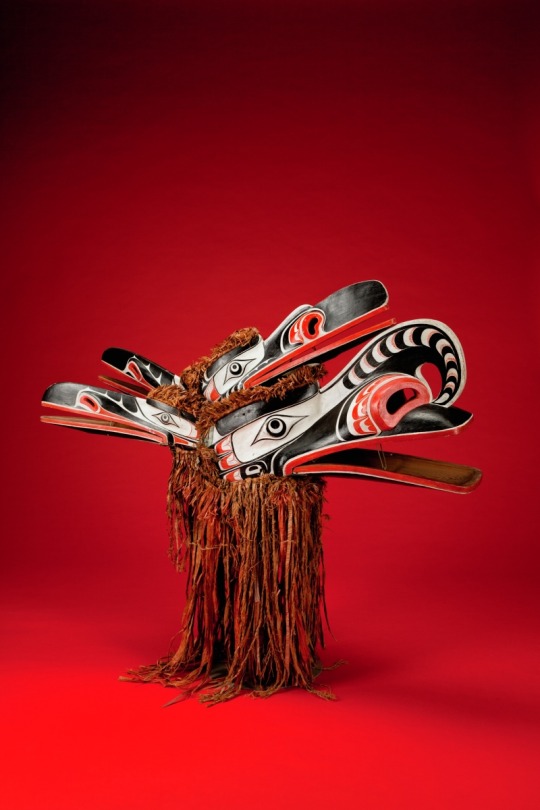
The Four-faced Hamat'sa Mask pictured was hand carved by George Walkus. Hamat’sa, refers to a sacred dance performed by the highest-ranking members of the Kwakwaka’wakw tribe, the tribe in which Walkus is from. Ritual dances are a practical form of story telling and culture preserving among indigenous peoples. The Hamat’sa tells the story of how the Kwakwaka’wakw tribe ancestors killing the beaked, cannibal beast. In turn, for defeating the beast the Kwakwaka’wakw were given his dances, songs, masks, and privileges to bestow upon future generations.
These dances primarily take place in the winter during holiday celebrations such as potlatch. Due to the important nature of such spiritual events for the Kwakwaka’wakw peoples, the masks need to be of the utmost quality. Walkus created his mask with dramatics in mind. The bold blocks of red along the beaks and nostrils bring attention to it’s most daunting features. The mask has cedar-bark fringe attached to the bottom of the mask to camouflage the wearer’s body. The beaks are also built within them, a mechanism that opens and closes the mouth making jarring noises throughout the dance. Everything about the mask is created to enhance the experience and storytelling for the viewer.
American People Series #20: Die, Faith Ringgold, 1967, Oil on Canvas

The 1950s through the 1960s marks the civil rights movement in America. The civil rights movement was a social justice movement where black Americans pushed for the same rights their white neighbors had enjoyed for centuries. Although a turning point in American history, the turn did not follow through without it’s fair share of sacrifices. During this period, black Americans faced huge amounts of backlash from white citizens, politicians, police officers, and so many more. This fallout resulted in the deaths of many black Americans who chose to fight and speak out regardless of the consequences. The civil rights movement came to an end officially on April 4, 1968 when Martin Luther King Jr. was assassinated. The outcomes of the movement, although a step in the right direction were only the beginning of the U.S accomplishing racial equality. The civil rights movement gave black Americans the right to vote, lifted public segregation, and created The National Association for the Advancement of Colored People (NAAP), among other achievements.
I believe the most powerful thing an artist can do is tell their truth, and this is precisely what Faith Ringgold does in her The American People Series #20: Die. Through the ongoing racial tension in the 1960s Faith Ringgold creates her American People Series which is a collection of 20 paintings that progressively display the relations between black and white Americans becoming more and more strained. The final piece, Die becomes the outcome of this strife. The painting unveils a bloody massacre between black and white Americans, men and women, the young and old, stating that the issues happening during the civil rights violence is not biased to any singular group of people. If we fall, we all fall together, I can imagine Ringgold saying while creating the piece.
Ringgold believed in the importance of documenting such a chaotic period because of the idea of preserving cultural identity, “How could I, as an African American woman artist, document what was happening around me?” Ringgold states about the painting, which to me says it all, as to why I chose this piece.
Camas para Sueños, Carmen Lomas Garza, 1985, Gouache on Paper
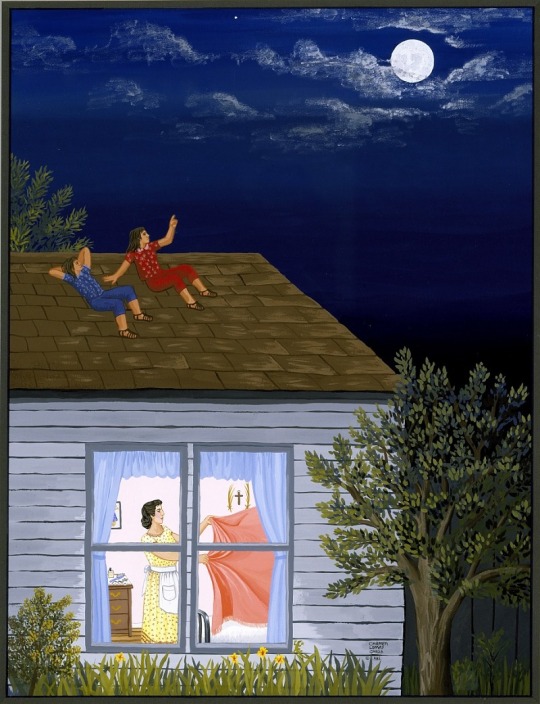
“Hope” is the first word that comes to mind when I view the piece, Camas para Sueños by Carmen Lomas Garza. The painting brings us into Garza’s childhood growing up as a Mexican female in America. Garza and her sister sit on the rooftop to her childhood home in South Texas, looking at the stars and dreaming of becoming artists. Below the children we see a window to the home, upon closer examination Garza’s mom can be seen tending to the household. What I find interesting about this glimpse into Garza’s childhood home is the symbolism she displays. Her mom seems to be wearing a dress along with an apron while doing chores, reminding me of the classic American housewife. In the house you can also see a cross hanging on the wall, suggesting her home upholds religious values. These two parallels create a tension in the painting, almost like Garza is being pulled into two different directions. Her wonder and exploration outside the household versus her conservative and traditional inside the household. I feel as though this artwork gives me a sense of hope, because of the reminder it gives of the power of children’s dreams, coupled with the fact that Garza’s artwork is being shown in museums today. Meaning, that the child’s dream does end up coming to fruition.
Aside from the painting, Garza credits her drive to create art to the Chicano Movement. The Chicano Movement was an effort led by Mexican Americans between the 1950s to 1970s, to gain equal rights as citizens of America. It was a radicalized movement meant to reclaim and liberate Mexican heritage and identity. It was largely focused on empowering the community, and in the case of Garza I would say it worked.
Do Women Have To Be Naked To Get Into the Met. Museum?, Guerilla Girls, 1989, Screenprint on Paper
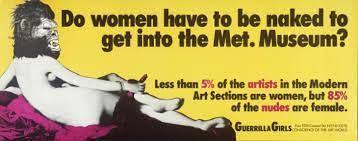
We had First Wave feminism, where the primary goal on the female agenda was to gain voting rights. In school we learn about activists such as Susan B. Anthony and Elizabeth Cady Stanton, and the first women’s rights convention held in Seneca Falls. Next, we had Second Wave feminism, which took place around the 1960s, so I could imagine why it gets overlooked in the curriculum due to the civil rights movement. Second Wave feminism was mainly focused on the wage gap and overall discrimination of females in comparison to males politically. Then we get to Third Wave feminism, which is brushed off in many textbooks, and is generally looked down upon due to it’s radical nature. I would define the Third Wave feminist agenda as honing in on the social constructs of being a women, completely burning the concept down, and rebuilding it from the ground up. The new identities they were creating for themselves and the means in which they were creating them, put many off at the time.
This is the ideology that gave space for artists such as the Guerrilla Girls to voice their discontent with male superiority. In their piece Do Women Have To Be Naked To Get Into the Met. Museum?, they speak out against the Met Museum’s insistence on putting females bodies on display over putting females artist’s artwork on display. They are making a call to action against the male gaze. The poster shows a classic reclining female nude and put a guerrilla mask on her head (alluding to their name), next to a quote in bold letters “Do Women Have To Be Naked To Get Into the Met. Museum?”. Below the bold lettered quote is a caption that articulates the percentage of female nudes in the Met. Versus the percentage of female artists work in the met. The poster is one of 30 apart of a magazine collection titled ‘Guerrilla Girls Talk Back’. The posters are a call to action to females around the U.S to fight the norms of womanhood and stand for equality.
Bar Boy, Salman Toor, 2019, Oil on Wood
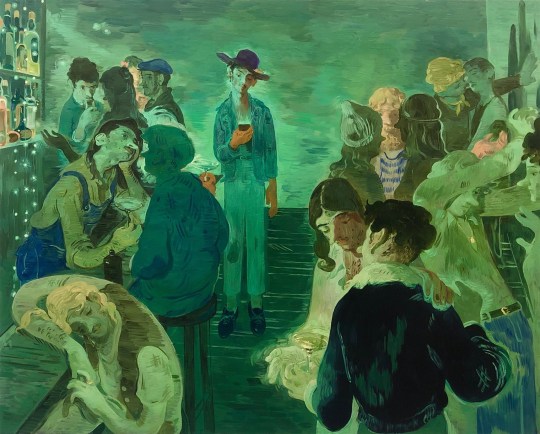
Salman Toor is a Pakistani-born, queer artist, who painted the piece Bar Boy. In this painting Toor illustrates a crowded bar scene, with the focal point being a slender male visibly in his own bubble in comparison to the rest of the bar patrons. The male is illuminated by the light of his phone screen, seemingly discontented from those around him. The painting could suggest the discontent the youth feel about dating in the modern era, with online dating, and hookups. Though it seems like the male is unphased by this realization, or maybe he is a part of the problem, taking an interest in his phone rather than in those around him. Maybe, Toor himself is discontent with modern American culture.
2 notes
·
View notes